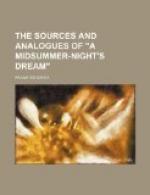Everything, then, points to the Celtic legends as the chief origin of the mediaeval fairy-lore; and the early Celtic literature, although its study, complicated by an unfamiliar language, has only recently been undertaken scientifically, has already revealed an extremely rich and complete store of romance that extends over a thousand years. From manuscripts which are attributed to the twelfth century (and even so contain matter rightly belonging to the ninth or tenth), we can trace the development of a creed concerning supernatural beings through the succeeding centuries, down to a time at which the written account is displaced by recorded oral tradition. A race of beings, who must originally have fallen from the Celtic Olympus, continue to appear, with characteristics that remain the same in essence, and under a designation that may be heard in Ireland today, through ten centuries of Irish tradition and literature.[76]
These people are called in Irish mythology the Tuatha De Danann, described from at latest 1100 A.D. as aes sidhe, “the folk of the [fairy-] hillock;” the name for fairies in Ireland now is “the Sidhe."[77] Originally, it may be, the aes sidhe were not identified with the Tuatha De Danann; and before the twelfth century the Sidhe were not associated with the Celtic belief in “a beautiful country beyond the sea,” a happy land called by various names—Tir-nan-Og (the land of youth), Tir Tairngire (the land of promise)—which has now become “fairy-land.” In the earliest heroic legends the Tuatha De Danann assist or protect mortal champions, and fall in love with mortal men and maids; but with the spread of Christianity (as might be expected) they lost many of their previous characteristics.[78]
To look back for a moment, we must note that so far we have touched no belief later than the fifteenth century, and already we have seen enough blending of various superstitions and legends to give our fairies a very mixed ancestry. Classical mythology, Celtic heroic sagas and northern Eddas in the tenth, eleventh, and twelfth centuries, Saxo the Danish historian in the twelfth, and a series of romances, running through Celtic-Breton-French-English languages from the twelfth to fifteenth centuries—all combine to alter or add to the popular conception of fairies. Celtic Mider is of human stature, beautiful, powerful, dwelling beneath the earth; he attempts to carry off a mortal bride. Teutonic Alberich is a dwarf, presumably not handsome, but well disposed to mortals. But when we come to Huon of Bordeaux we find Oberon’s characteristics are derived from varying sources. He himself describes[79] to Huon, in a fantastic romance-style, which attempts to associate him with as many classic heroes as possible, his parentage and birth:—
“I shall show thee true, it is Julius Caesar engendered me on a lady of the Privy Isle ... the which is now named Chifalonny [Cephalonia] ... after a seven year Caesar passed by the sea as he went into Thessaly whereas he fought with Pompey; in his way he passed by Chifalonny, where my mother fetched him, and he fell in love with her because she showed him that he should discomfit Pompey, as he did.” We are almost supplied with the date of Oberon’s birth.




